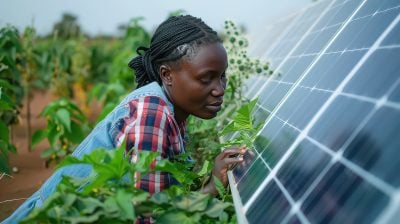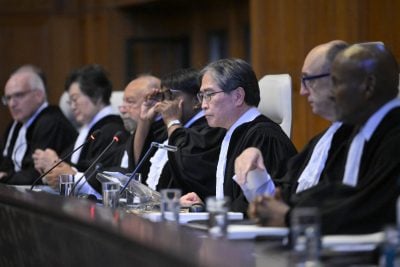The government of Cameroon is starting to take its environmental responsibilities more seriously, with an increasing number of recycling and renewable energy projects being developed.
Yet by some measurements, the country is already performing well. Its carbon emissions stand at about 8.62m megatons a year, according to World Bank figures, which translates into very low per capita emissions by international standards.
However, the country’s methane emissions are higher and rising because of the level of animal agriculture in the country. Nevertheless, at the 21st United Nations Conference on Climate Change (COP21), which was held in Paris in 2015, Cameroon committed to reducing its carbon emissions by 32% by 2030.
It is important that environmentally sustainable approaches are incorporated in all government policies, otherwise dedicated projects could be seen as a form of greenwashing.
Yaoundé has sought to encourage organic farming and has drawn up a draft bill governing organic production in the country. A significant proportion of Cameroon’s annual harvest is produced without using pesticides or other chemical inputs but is not classified as organic because of the lack of controls and certification.
Plastic solutions
Plastic pollution has long been a big problem in most of Africa, particularly through plastic bag waste but also through the growing use of other plastic containers, while recycling infrastructure tends to be limited.
Plastic blocks drains, exacerbating the impact of flooding and providing breeding grounds for mosquitoes, while much of it enters waterways and eventually reaches the ocean, impacting marine wildlife and entering food chains. Some communities burn their waste but this releases harmful compounds and also contributes to climate change.
In order to tackle the problem, the government of Cameroon has announced plans for a plant in Kousseri in the Far North that will recycle plastic waste into paving stones. The project will recycle rubbish, create a supply chain and generate employment for young people in the area.
The Lake Chad Region Recovery and Development Project (Prolac) is currently seeking to recruit an NGO with experience in the sector to manage the factory, possibly alongside a private sector contractor. Prolac was set up in 2020 with €157m in funding from the International Development Association to promote sustainable development in the Lake Chad Basin.
Further south, an NGO called WasteAid is ramping up its waste management and plastic recycling capacity in Douala with funding from British distribution and outsourcing firm Bunzl. It is also working to promote recycling systems in the city. Employees collect waste by handcart and take it to a central plant for compacting and then onward supply.
The Head of Sustainability at Bunzl, James Pitcher, commented: “WasteAid’s projects help communities in lower-income countries to set up waste collection and recycling services that protect the environment and provide livelihood opportunities.”
WasteAid CEO Ceris Turner-Bailes said: “Pollution from poorly managed waste affects us all, whether through health impacts, marine plastic pollution or climate change. This ongoing partnership means more people can benefit from being part of a circular economy, with all the long-term benefits this brings.”
Focus on renewables
Cameroon is also making rapid progress on developing low carbon power generation, although there is some controversy over the biggest projects as they take the form of big dam schemes. Large hydro projects do generally produce relatively low greenhouse gas emissions but the devastation caused by construction, both in terms of the impact on flora and fauna and on local people, means that they are not generally defined as renewable power projects.
The biggest project under construction is the 420MW Nachtigal scheme, which is now expected to produce first power in mid-2023 following pandemic-related delays. Located 65km from Yaoundé, it is being developed by Nachtigal Hydro Power Company, which in turn is owned by Electricité de France, Société financière internationale, Africa50 and STOA Infra & Energy.
The project price tag of CFA786bn ($1.3bn) includes the cost of the new transmission lines, which are being developed by Bouygues Energies & Services. Such big projects are often criticised because the areas in which they are developed receive all of the impact but often none of the electricity. In this case, a small 4.5MW plant will supply power to communities in the immediate vicinity of the dam.
Nachtigal could be overshadowed by the larger 600MW Chollet hydro scheme, if it is eventually built. In April 2021, the governments of Cameroon and Congo-Brazzaville awarded China Gezhouba Group a concession to develop the project on the River Dja along their common border, with output to be shared by the two countries.
The project is expected to be completed by 2025 but few details have been released. Elsewhere in Cameroon, the government is seeking funding from China’s Exim Bank for the 72MW Menchum hydro scheme in the northwest, while work on the 30MW Lom Pangar dam in the east is approaching completion.
Micro and small hydro schemes do fall within the definition of renewable energy and several new projects are being developed in Cameroon, such as the 1.48MW Mbakaou mini hydro project, which was completed in April. Developed as a public private partnership between the government, French firm IED and power utility Eneo, it was built on the Djérem River, a tributary of the Sanaga River in Adamaoua region.
It is connected to the town of Tibati by a 40km transmission line and will supply power to 40,000 people under Cameroon’s rural electrification programme. The combined cost of the hydro scheme and power line was CFA3.5bn (€5.4m), while the project’s completion will allow the closure of small thermal plants at Tibati, Ngaoundal and Mbakaou, reducing annual carbon emissions by an estimated 7,444 tons a year.
Also in April, the government announced plans for two further mini hydro plants at Widikum and Menka in the Northwest of the country.
Details on the scale of the projects have not yet been revealed but it is expected that they will supply power to a new soap factory and oil mill, as well as providing electricity to more rural homes.
Projects to build the country’s first large solar power facilities have now been agreed. In December, developer Scatec signed deals with Eneo to build a 36MW PV plant with 20MW storage capacity by mid-2022. Solar PV construction and operating costs have fallen rapidly worldwide, making them a cheap option for African economies and also the most obvious way of building up decentralised power production.
Power storage technology is at an earlier stage of development, so Cameroon will become one of the first African countries to acquire storage plants. However, costs here too are falling, with storage key to ensuring high solar penetration rates.
Cameroon’s solar resources are concentrated in the Far North, where average solar irradiance stands at 5.8kWh/m2/day, in comparison with 4.0–4.9kWh/m2/day in the south, so new transmission infrastructure will be required to enable projects to benefit the whole country.
In addition, under its rural electrification programme, the government is committed to ensuring that 500MW of PV capacity is developed in off-grid locations, although the timetable is uncertain.
Want to continue reading? Subscribe today.
You've read all your free articles for this month! Subscribe now to enjoy full access to our content.
Digital Monthly
£8.00 / month
Receive full unlimited access to our articles, opinions, podcasts and more.
Digital Yearly
£70.00 / year
Our best value offer - save £26 and gain access to all of our digital content for an entire year!
 Sign in with Google
Sign in with Google 



